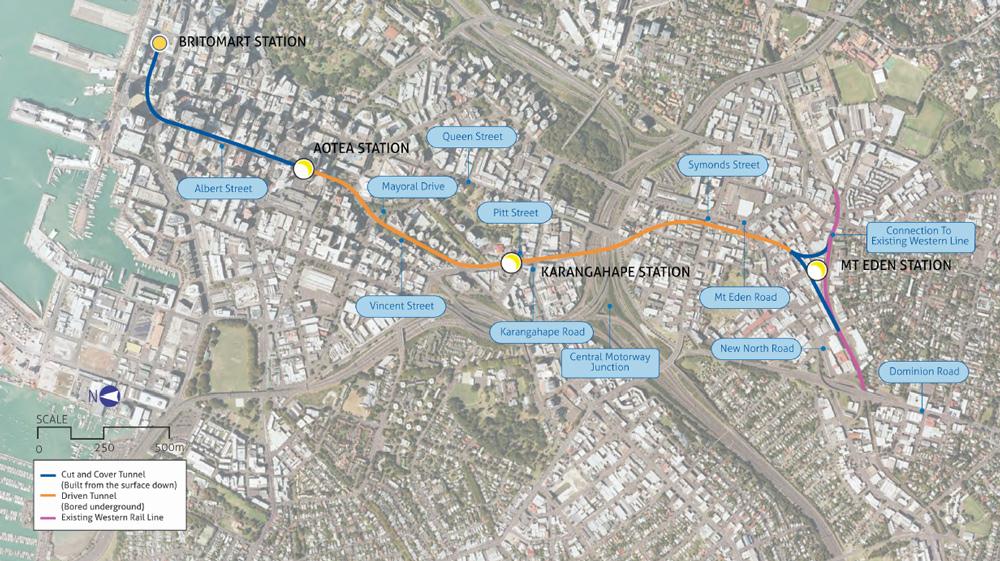
4 minute read
3. Summary of contamination assessment
3.1 Overview
Contamination investigations conducted for the CRL project to support obtaining the necessary planning approvals for works in the Mt Eden area are documented in the following reports.
City Rail Link: Contaminated Land Assessment July 2012, prepared by AECOM; Auckland City Rail Link: Aotea Station to North Auckland Line Construction and CRL Operation Contaminated Land Assessment May 2016, prepared by Golder Associates; and Auckland City Rail Link: Aotea Station to North Auckland Line Construction and CRL Operation Contaminated Land Assessment –South Pacific Timber July 2016, prepared by Golder Associates.
The contaminated land assessments undertaken for the CRL works in the Mt Eden area comprised an assessment of soil and groundwater. For accessibility and logistical reasons, the soil and groundwater investigations did not necessarily target specific locations but were positioned to provide an overview of potential ground contamination constraints.
3.2 Geology and hydrogeology
The geology in the CRL Mt Eden Enabling Works area comprise the following:
Fill –surficial fill variably comprised of clays, silts, sands and rubble. Fill is typically up to approximately 4 m bgl. The composition and thickness varies irregularly; Tauranga Group (TA) –alluvium, typically composed of clayey to sandy silts. These sediments are derived predominantly from erosion of East Coast Bays Formation (ECBF). Some areas of very soft TA and high organic content TA have been encountered; ECBF –a sequence of sandstone beds with interbedded mudstone and siltstone layers; and Auckland Volcanic Field (AVF) –three distinct lithologies present; ash, tuff and basalt lava.
Fill is typically underlain by TA/ECBF but within the works area there are areas underlain by AVF. Several groundwater monitoring wells have been installed in the vicinity of the works area. Groundwater levels indicate the presence of perched groundwater recorded between 0.5 m and 2 m bgl. Additional groundwater details are included within the Groundwater and Settlement Monitoring and Contingency Plan (GSMCP) prepared for the Mt Eden Enabling Works.
3.3 Soil quality
Intrusive investigation work has been undertaken on public land and within road reserves around the CRL project alignment and have not specifically assessed potential contamination on private properties.
Soil quality testing undertaken in and around the Mt Eden Enabling Works area has largely focused on potential contaminants of interest likely to be associated with the urban land use. More targeted investigations were also undertaken at the South Pacific Timber site (21 Ruru Street) which makes up the south-western portion of the Mt Eden Enabling Works area. The South Pacific Timber site was formerly part of a railway marshalling yard until the tracks through the area were removed in the 1960s to 1970s. South Pacific Timber had leased their site for approximately 20 years sealing the site with concrete on occupation. The South Pacific Timber site has been used for timber storage and distribution; timber treatment activities have not been undertaken at the site.
Soil analysis comprised the following common contaminants considered appropriate for fill with unknown origin and road infrastructure:
Asbestos (within the test pits at the South Pacific Timber site only); Metals; Polycyclic aromatic hydrocarbons (PAH); and/or Total petroleum hydrocarbons (TPH).
The NES Soil regulations provide a set of chemical specific soil contaminant thresholds that define an adequate level of protection for human health for a range of differing land-uses in New Zealand (referred to as soil contaminant standards or SCS). For the Mt Eden Enabling Works, the NES SCS for commercial/industrial land use has been adopted. All results complied with the adopted NES SCS, with the exception of the benzo(a)pyrene equivalence (BaP eq ) concentrations in several shallow fill samples.
Asbestos in soils was also investigated within the 11 test pits advanced in accessible areas of the South Pacific Timber site. Asbestos was detected in shallow fill in 2 of 16 samples. The samples positive for asbestos were logged with demolition rubble containing glass. These samples were re-analysed to determine the concentration of asbestos in the samples. The NZ Asbestos in Soil Guidelines 1 provides criteria of 0.05% weight/weight (w/w) ACM and 0.001% w/w for AF/FA for commercial/industrial land use. Asbestos concentrations in one of the samples were reported as <0.001% weight/weight (w/w) for both ACM and combined asbestos fines (AF) and friable asbestos (FA). For the other sample, a concentration was unable to be determined as the single bundle of fibres identified had been removed for identification in the first analysis and unable to be recovered.
Results in several samples exceeded the Auckland Council criteria for discharges to the environment (previous and current adopted criteria). Copper, lead, zinc and BaP eq concentrations within shallow fill exceeded the discharge criteria. Fill material also exceeded the published background concentrations for volcanic and non-volcanic soils in Auckland as described in the Auckland Regional Council Technical Publication 153 –Background Concentrations of Inorganic Elements in Soils from the Auckland Region (TP153).
Fill material will be removed during the works and will require appropriate disposal (refer Section 5.4).
3.4 Groundwater quality
Groundwater information is available for a number of locations on public land and within road reserves along the CRL project alignment. Groundwater quality in and around the Mt Eden Enabling Works area indicates elevated concentrations above ANZECC 95% marine trigger values for chromium, copper, lead and zinc. Concentrations, particularlyoftotal copper, were found to also exceed 50 times ANZECC 95% marine trigger values.
Groundwater will be encountered during the Mt Eden Enabling Works. Groundwater and surface water will require management prior to disposal (refer Section 5.6 and the ESCP prepared for the Mt Eden Enabling Works).
Page 16 | Mt Eden Enabling Works 1 BRANZ, 2017, New Zealand Guidelines for Assessing and Managing Asbestos in Soil




